Samsung's Galaxy Tab S 10.5 & 8.4: Hands On with Samsung's 6.6mm Thin Tablets
by Anand Lal Shimpi on June 12, 2014 8:00 PM EST- Posted in
- Tablets
- Samsung
- Mobile
- Galaxy Tab S
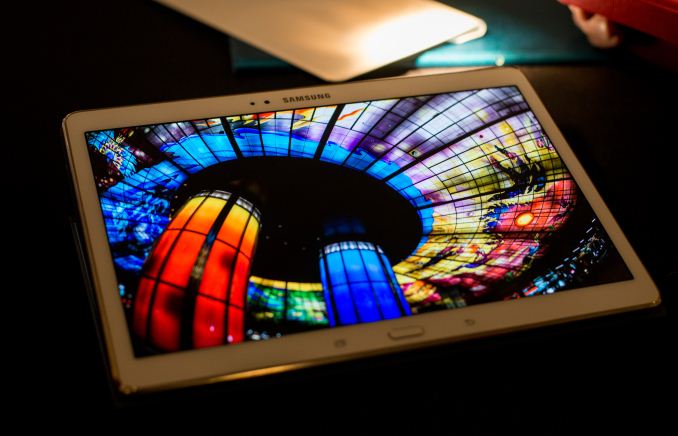
I remember sitting in a briefing with Samsung last year when the company first started talking about translating its success in the Android smartphone space into the tablet market. Samsung has done well in the Android tablet space but it’s safe to say that the company is better known for its phones. This year Samsung hopes to change all of that and is putting its most valued mobile sub-brand (or letter) to work in tablets. Later this month (globally) and starting next month in the US, Samsung will begin selling its Galaxy Tab S line of premium tablets.
From the very beginning you can tell things are different with the Tab S. The Galaxy Tab S will be available in two different sizes, both with a 16:10 aspect ratio: 10.5” and 8.4”. Each size comes in two different colors: dazzling white and titanium bronze.
The Galaxy Tab S models are styled quite similarly to the Galaxy S5. The front of the device features a dedicated home button (with integrated fingerprint sensor), flanked by recent apps and back buttons. The back of the device is covered in a non-hyperglaze polycarbonate with a textured pattern that looks similar to the back of the GS5. The actual back surface feels a bit smoother than what you get on the GS5.
Both devices are incredibly thin and light. The table below puts their dimensions in perspective:
| Dimension Comparison | |||||||||
| Samsung Galaxy Tab S 10.5 | Samsung Galaxy Tab S 8.4 | Apple iPad Air | Apple iPhone 5s | Samsung Galaxy S5 | |||||
| Length | 247.3 mm | 212.8 mm | 240.0 mm | 123.8 mm | 142.0 mm | ||||
| Width | 177.3 mm | 125.6 mm | 169.5 mm | 58.6 mm | 72.5 mm | ||||
| Thickness | 6.6 mm | 6.6 mm | 7.5 mm | 7.6 mm | 8.1 mm | ||||
| Weight | 465g | 294g | 469g | 112g | 145g | ||||
At 6.6mm thick, both models of the Galaxy Tab S are thinner than the iPad Air, iPhone 5s and Galaxy S5. Samsung is able to leverage the extremely low profile afforded by its Super AMOLED display to help drive chassis thickness to incredibly low levels.
I noticed absolutely no fatigue in holding either device in a single hand. I think we’re finally nearing the ideal thickness and weight for content consumption tablets.
The Display: 2560 x 1600, Super AMOLED
Both Galaxy Tab S models feature a 2560 x 1600 Super AMOLED display. According to Samsung, the 10.5” model features a full RGB stripe, while the 8.4” Tab S has a diamond PenTile subpixel structure. I always forget to bring my macro lens to these things but both panels appeared to use a weird subpixel structure to my unaided eye. I'll confirm when I get my hands on a review device.
Both tablets feature Samsung’s new Adaptive Display mode that adjusts the tint of the display based on the color of ambient light, but the usual predefined color modes should be present as well. On the global demo units I played with there were four operating modes (including adaptive display), although these tend to get renamed when we eventually get them on US models. I’m hoping Samsung’s color accuracy tuning on the GS5 made its way to the Tab S as well.
The Fingerprint Scanner
Like the GS5, the Tab S integrates a swipe fingerprint scanner into the device's home button. Samsung appears to either have improved the behavior of the fingerprint scanner in the Tab S or it’s just easier to use on a tablet laying flat compared to a handheld phone. I suspect the reality is a combination of both. I registered my left index finger on one of the Tab S devices and had no issues unlocking the device. With the GS5 I found that my swipes had to be deliberately paced, but on the Tab S I could swipe fast or slow or at an inconsistent rate and still trigger a successful unlock.
I didn’t try using the fingerprint scanner on the Tab S with the tablet held in the air or propped up at an angle so there’s lot more to try when I get my hands on a review unit.
The Internals: SoC, Connectivity and Battery
| Samsung Galaxy Tab S Specifications | ||||||
| Galaxy Tab S 10.5 | Galaxy Tab S 8.4 | |||||
| Dimensions | 247.3 x 177.3 x 6.6mm | 212.8 x 125.6 x 6.6mm | ||||
| Display | 10.5-inch 2560 x 1600 Super AMOLED (RGB stripe?) | 8.4-inch 2560 x 1600 Super AMOLED (Diamond PenTile) | ||||
| Weight | 465g | 294g | ||||
| SoC | Exynos 5 Octa (4 x Cortex A15 1.9GHz + 4 x Cortex A7 1.3GHz) or Qualcomm Snapdragon 800 2.3GHz | Exynos 5 Octa (4 x Cortex A15 1.9GHz + 4 x Cortex A7 1.3GHz) or Qualcomm Snapdragon 800 2.3GHz | ||||
| Connectivity | 802.11a/b/g/n/ac 2x2 + BT 4.0, USB 2.0, GPS/GNSS/Beidou, WiFi Direct, Optional Cellular in Certain Markets | 802.11a/b/g/n/ac 2x2 + BT 4.0, USB 2.0, GPS/GNSS/Beidou, WiFi Direct, Optional Cellular in Certain Markets | ||||
| Memory | 3GB | 3GB | ||||
| Storage | 16GB/32GB + microSD | 16GB/32GB + microSD | ||||
| Battery | 7900mAh (30Wh?) | 4900mAh (18.6Wh?) | ||||
| Starting Price | $499 | $399 | ||||
Internally the Galaxy Tab S features either a Samsung Exynos 5 Octa (5422?) SoC or a Qualcomm Snapdragon 800 (no word on why Samsung opted against using an 801). WiFi-only models will ship with the Exynos 5 Octa, while cellular variants in North America will ship with Qualcomm’s MSM8974v3 silicon (and integrated LTE modem). Global variants with cellular connectivity will support voice calls from the device itself, however US LTE models will not.
All devices ship with 3GB of LPDDR3 and a minimum of 16GB of NAND on-board. Global variants will be offered with 32GB as an option. A microSD card slot is standard on all Galaxy Tab S devices.
Like the Galaxy S5, the Galaxy Tab S supports 2-stream 802.11ac - likely using the same Broadcom controller. Samsung’s download booster function is also supported (on models that feature both WiFi and cellular connectivity).
Unlike the GS5 however, there’s no USB 3.0 support on either Tab S. There’s a single micro USB 2.0 port on the right side of the device for charging/sync. Internally the 10.5” model has a 7900mAh battery, while the 8.4” model has a 4900mAh battery. Samsung didn’t disclose the voltage of either battery, assuming a standard 3.8V chemistry we’re looking at 30Wh and 18.6Wh, respectively.
The Software
The Tab S line features the same updated TouchWiz UI that debuted on the Galaxy S5. That includes flatter iconography and widgets, reduction in the number of quick settings options and a simplified camera UI. In my brief hands on with the tablets I did notice some other improvements. The biggest? Bringing up the recent apps list has a much shorter lag associated with it on the Tab S compared to the Galaxy S5. I did notice some infrequent hiccups in UI frame rate in using the Tab S, which is to be expected given the extremely high display resolution vs. GPU power/bandwidth under the hood.
The new Tab S features SideSync, which allows you to stream and interact with a paired Galaxy S5 over WiFi Direct. With SideSync running, you can access almost all of the features of a paired GS5 device (minus things like Camera) directly from the Tab S. You’re presented with a virtual GS5 on the Tab S’ display, which you can also take full screen. The UI and any content is streamed over WiFi between devices so there’s a bit of lag (and understandable sub-30fps UI frame rate). Samsung demonstrated running Candy Crush on a GS5 streamed to a Tab S over WiFi Direct. For applications that don’t demand instantaneous response, you can absolutely stream them remotely.
With SideSync enabled and linked to a GS5 you can also answer phone calls on your Tab S (including the ability to switch between Tab S and GS5 in the middle of a call).
The Covers & Accessories
Samsung has a handful of first party accessories launching alongside the Galaxy Tab S. Rather than relying on magnets to attach covers to the device, both Tab S models have two indents on the back that can accept a button mounted cover. Attaching a cover to the Tab S is a lot like buttoning pants or a shirt, line up the indents with the buttons on the cover and apply pressure to snap the two together. To remove the cover just hold the tablet and cover in opposite hands and pull the two apart. I have to admit it’s an odd sensation on a tablet, but it results in a sturdy connection and it works. I suspect Samsung was primarily motivated to reduce costs here though.
The Tab S cover can be folded into three different stand positions: typing mode, touch mode and view mode. The positioning flexibility comes at the expense of design complexity. There’s a steeper than expected learning curve to getting the hang of how to properly fold the cover to achieve the right operating mode.
Samsung also offers a Bluetooth keyboard accessory with similar styling to the Tab S.
The Availability
Beginning in July in the US the Galaxy Tab S 8.4 will be available at $399 (16GB/WiFi), while the 10.5” model will retail for $499 (16GB/WiFi). The LTE versions will come to AT&T, Sprint, T-Mobile and Verizon. AT&T, Sprint and T-Mobile will carry the 10.5" model while Verizon will launch with both the 8.4 and 10.5" models. Global variants will be available in select markets later this month.


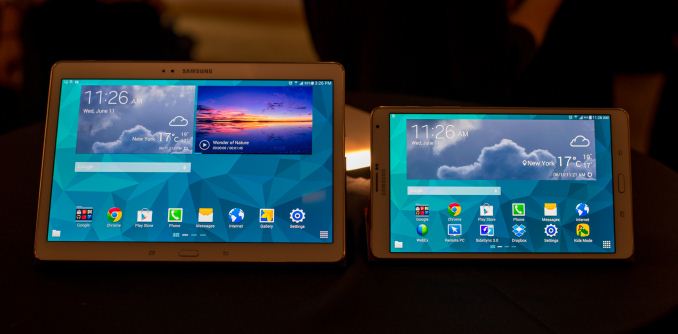






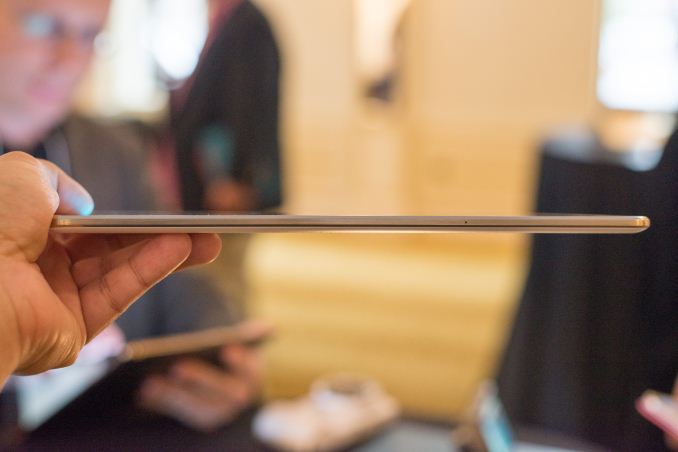
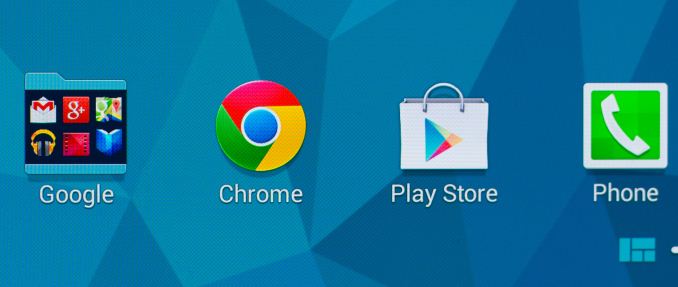
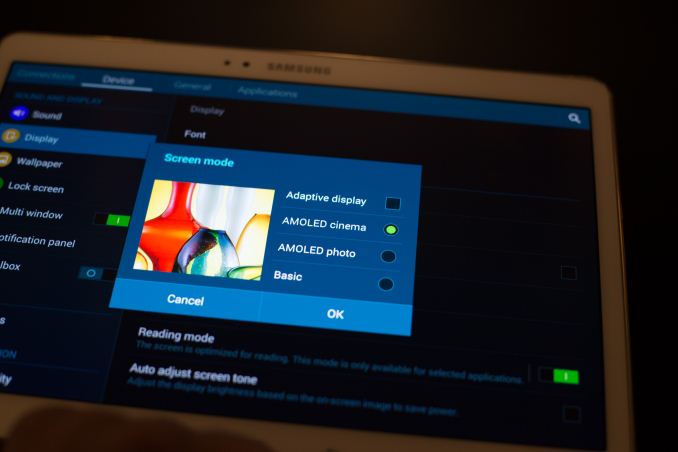
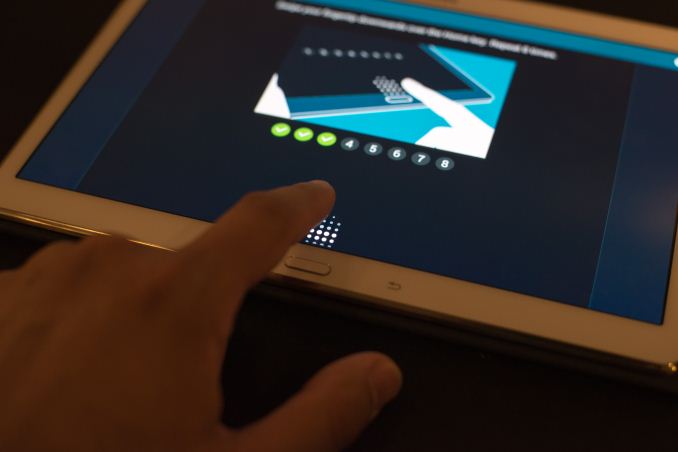

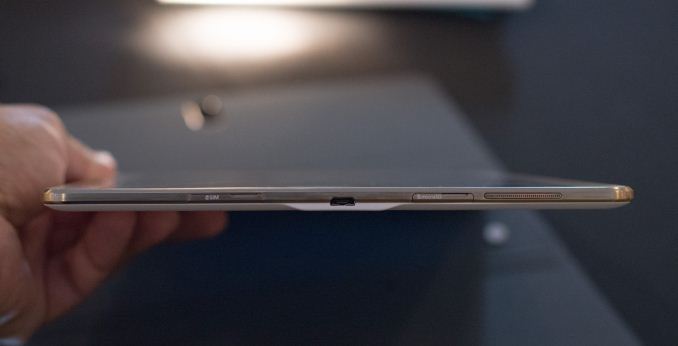
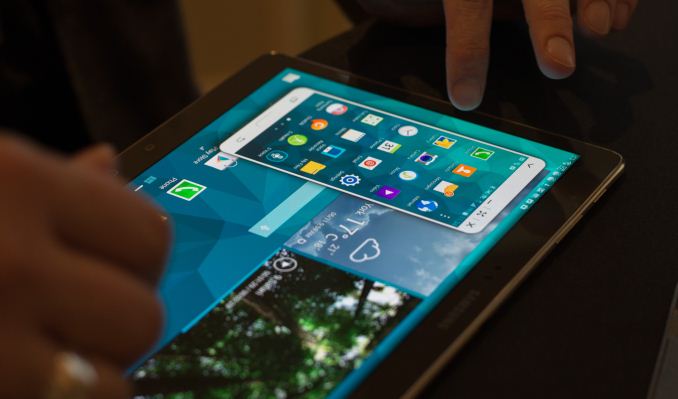
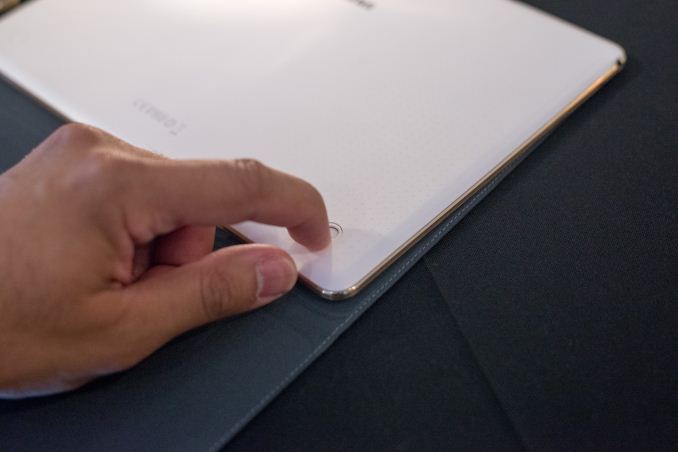
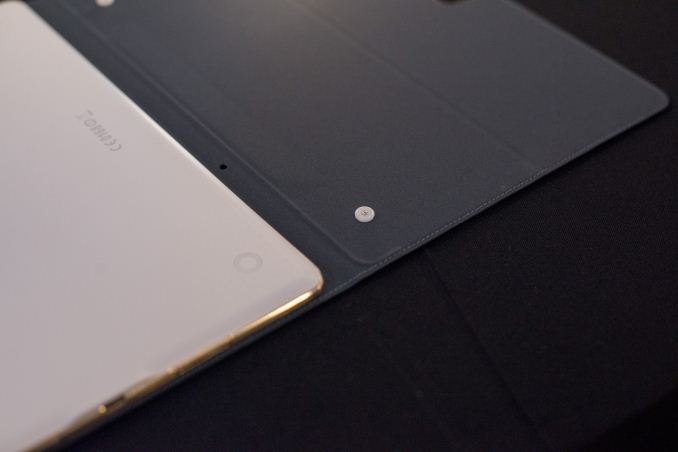
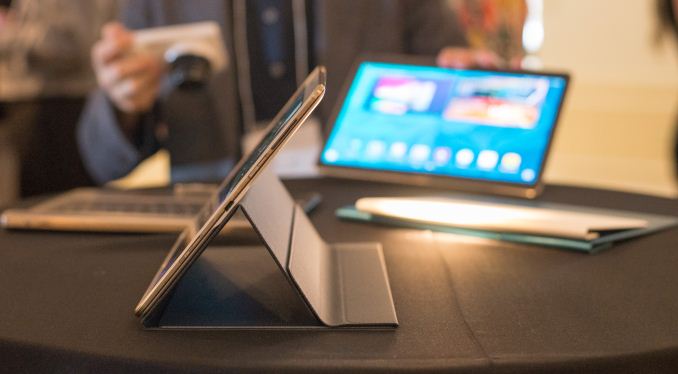
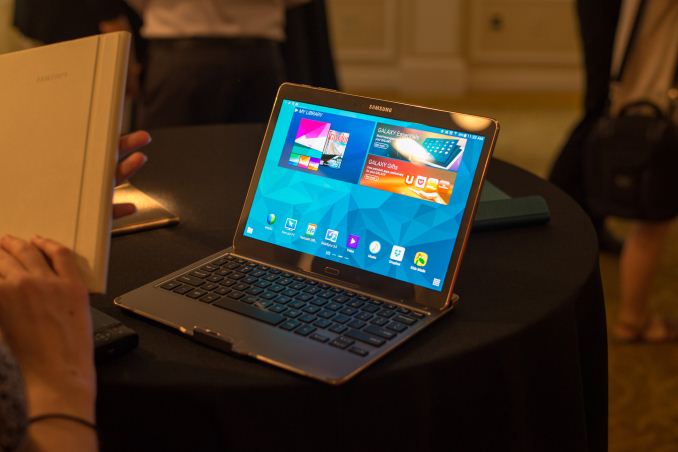








82 Comments
View All Comments
UltraWide - Thursday, June 12, 2014 - link
$499 for the 10.5"$399 for the 8.4"
AP27 - Monday, June 16, 2014 - link
It feels like anyone who bought a Tab PRO got burned here (the 10.1 and 8.4 models). They were just announced 8lin January and they've already been replaced with a thinner model with a (arguably) better display. I understand that the tech world moves fast, but 5 months is pushing it.That 8.4 Tab S is looking really nice! Looking forward to battery life reports.
gamer1000k - Thursday, June 12, 2014 - link
Yet another promising tablet crippled by only 16GB of internal storage.Are there even any sub-10" android tablets with 32gb+ internal memory and microsd for sale in the US? If anyone knows of any I'm shopping for a new android tablet and have been disgusted so far with the pitiful amounts of internal storage everyone seems to be using for their tablets and not even providing an option to buy the higher capacities (I know the nexus 7 comes in 32gb, but it doesn't have microsd and wouldn't work for me).
ddriver - Thursday, June 12, 2014 - link
Article says there is 32gb option + SD card slot = 96 GB total storage. Just get a "global" version if you are not happy with what local carries are pushing to local chumps.gamer1000k - Thursday, June 12, 2014 - link
Many of the other recent samsung android tablets have been listed as having 32gb options as well, however these models seem to be destined for other markets and there hasn't been any mention at all of 32gb availability in the states even though tablets like the galaxy tab pro 8.4 have been on sale for several months now. That's why I'm skeptical about being able to actually get a "global" version without having to import it.hrrmph - Friday, June 13, 2014 - link
I've had no problems getting Blackberry, GoPro, and Samsung devices to take 128GB Micro-SD storage chips.So I'm guessing these tablets should work fine with 16GB + 128GB = 144GB.
If you need more storage, then the Microsoft Surface Pro 2 will do that, but you will then lose any hope of buying a tablet with any built-in 4G or 3G telephony voice or data capabilities.
skrewler2 - Friday, June 13, 2014 - link
I've got a 2014 Note 10.1. 16GB with 64GB SD, but unfortunately you can't install apps onto the SD card.. just stuff like movies/music/photos. I thought 16GB would be enough but I'm constantly out of space.Same problem on my Galaxy S4.
Have tried some apps that are supposed to workaround this issue, foldermount and such, but haven't had any luck with them.
theduckofdeath - Saturday, June 14, 2014 - link
Find app alternatives that do support SD. I think I've always something like 5-8GB free space on my GS4. All apps that need large amounts of storage for me support SD. If they don't I just find a better alternative.gearheadvr4 - Sunday, June 15, 2014 - link
I have lots of available space on my 16gb Note 10.1. I installed a 64gb card and loaded nearly every app to the SD card. The way to go is to root. Without root some of the large game files and programs cannot move the entire app to SD. What most of the "move to sd" apps do is only move the executable part not the game files where the bulk of the data is. So root, then use the correct apps... like GL to SD(root).The only things you shouldn't move are
Widgets – no matter how menial in usefulness or design.
System tools – many might not operate as intended without being on the phone’s storage.
Important apps – you don’t want to risk an important app becoming inaccessible when you need it.
Ev1lAsh - Monday, June 16, 2014 - link
Had a similar problem with my Galaxy S2. In my case, because I had it so long, and I guessed used so intensively, the internal logs got quite big.I used sysDump (dialler *#9900#) to delete and freed up a gig (I believe 200-300mb is more common), and now I don't get storage memory warnings. It seems smoother, but that could be just my perception, or some of the app updates.
This mightn't help you at all, but thought I mention it in case it does.
PS
The logs are hidden system files, so apparently if you can't open sysDump you have to root the phone and install certain apps to see them and truncate them.
Obviously back everything up, before doing this or sysDump.
If you can use sysDump to delete, the device will restart when done, and for my phone was unresponsive for a few minutes when it was deleting/truncating the logs.